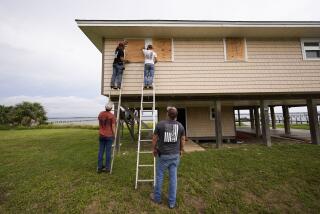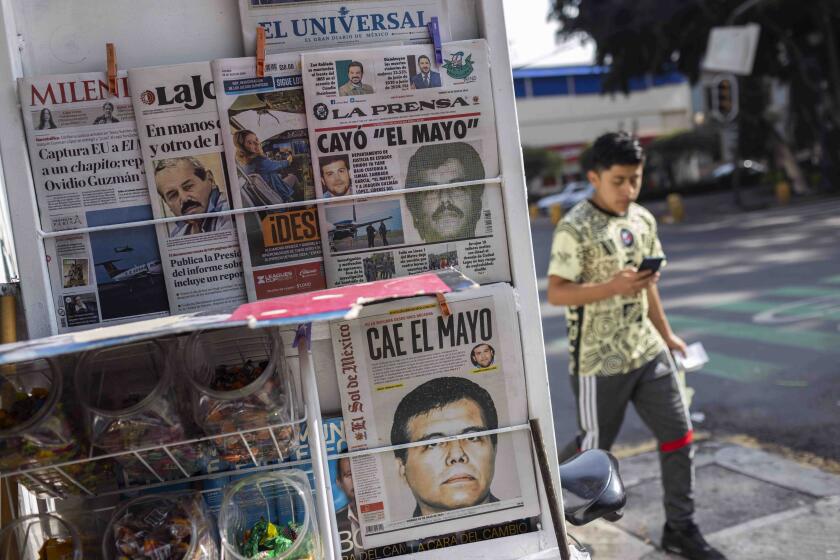Stopping Uganda’s war on children
HIS PICTURE has been on my office bulletin board for almost a decade now: a skinny little boy of 7 or 8, his ears sticking out. He’s wearing a filthy sweatshirt that declares jauntily, “I’M A TOYS-R-US KID!”
But this boy has never been to Toys R Us. His sweatshirt is one of the ubiquitous First World castoffs that litter sub-Saharan Africa, and his expression is far from jaunty. In the snapshot, his left arm is folded over his chest, mostly covering the words “TOYS-R-US.” Unless you scrutinize the picture carefully, it looks like his shirt offers only a simple, mute reproach: “I’M A KID.”
I met him in 1997 in the northern Ugandan town of Gulu, which was then, as now, an epicenter of the Lord’s Resistance Army insurgency in Uganda. He was in the compound of an aid organization that housed children who had escaped from rebel captivity. I snapped his picture, and for some reason I’ve kept it ever since.
The rebels purport to be fighting the government of Ugandan President Yoweri Museveni -- who has been in office for 20 years and is running for a third term -- but for the most part they merely prey on the civilian population of northern Uganda, looting, slaughtering and mutilating civilians and abducting children.
Every war takes a fearful toll on children, but in some sense, the insurgency is a war on children. The United Nations estimates that since the conflict began in 1986, the rebels have kidnapped 25,000 Ugandan children, from toddlers to teens. They are forced to become servants, child soldiers and sex slaves. If an abducted child disobeys or is caught trying to escape, the typical punishment is to be beaten to death with clubs or hacked to death with machetes and knives.
In 1997, when I interviewed former captives on behalf of Human Rights Watch, one 16-year-old girl told us this story: “One boy tried to escape, but he was caught.... His hands were tied, and then they made us, the other new captives, kill him with a stick. I felt sick.... I refused to kill him, and they told me they would shoot me. They pointed a gun at me, so I had to do it. The boy was asking me, ‘Why are you doing this?’.... After we killed him, they made us smear his blood on our arms.... They said we had to do this so we would not fear death and so we would not try to escape....[But] I see him in my dreams, and he is talking to me and saying I killed him for nothing, and I am crying.”
A decade later, the insurgency continues unabated. Much of northern Uganda has been laid waste, and an estimated 1.7 million villagers have been displaced. Thousands of civilians have been killed, and in recent months the rebels have escalated attacks not only on villagers but on humanitarian workers.
Meanwhile, although government troops outnumber rebel forces by roughly 20 to 1 in the region, Museveni has made only halfhearted attempts to end the insurgency. Although several rebel leaders have been indicted by the International Criminal Court, neither Museveni nor other regional leaders have shown much interest in their apprehension. In the north, undisciplined government troops only add to local woes, raping, beating and stealing from the civilians under their “protection.”
The insurgency has recently showed renewed signs of spilling beyond Uganda. In Sudan, government elements are providing safe harbor and support for the rebels, imperiling the fragile peace agreement there. Rebel forces also recently made major incursions into the Democratic Republic of Congo, inflaming tensions between Congo, Uganda and the other states with troops and interests in the region.
The international community can’t afford to ignore this crisis. On Thursday, Ugandans went to the polls in the first multiparty election in 20 years. Whoever wins, the election offers a rare opportunity for a change in course on northern Uganda. Allies and donor nations -- especially the U.S. -- should push the Ugandan government to make capturing indicted rebel leaders a priority, provide incentives for non-indicted rebels to leave the bush and prevent and redress abuses by soldiers.
On the international side, the U.N. Security Council -- with U.S. leadership -- should recognize the conflict as a threat to international peace and security and develop a plan that, if necessary, authorizes third-party states to use force to apprehend the indicted rebel leaders. If top rebel leaders can be removed, all indications are that the insurgency might melt away rapidly.
Today, I no longer remember the name of that solemn little boy whose picture is on my bulletin board. If he’s still alive, he’s no longer a little kid. But, although it’s too late to save that boy’s childhood, it’s not too late to keep the conflict from destroying another generation of Ugandan children.
More to Read
Sign up for Essential California
The most important California stories and recommendations in your inbox every morning.
You may occasionally receive promotional content from the Los Angeles Times.










